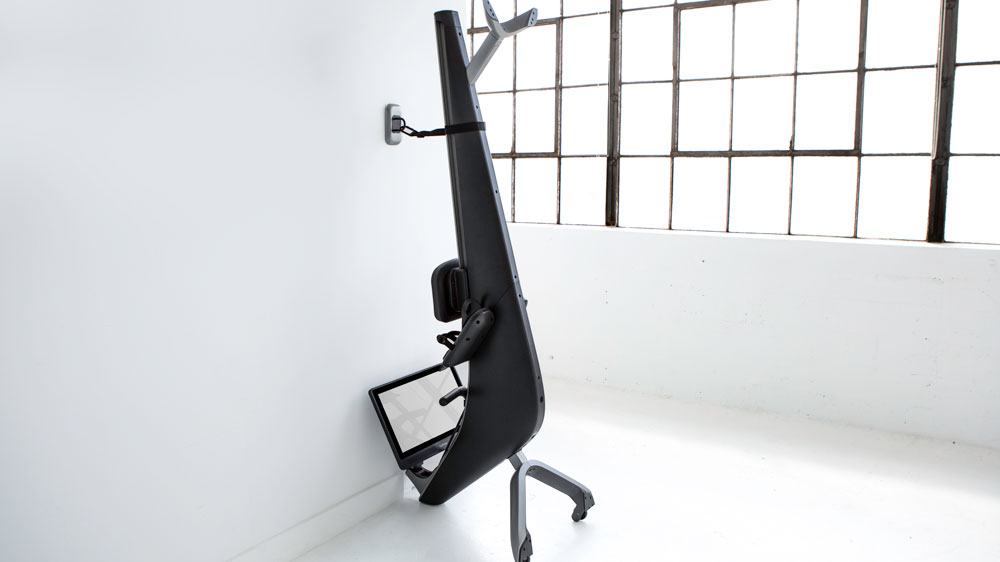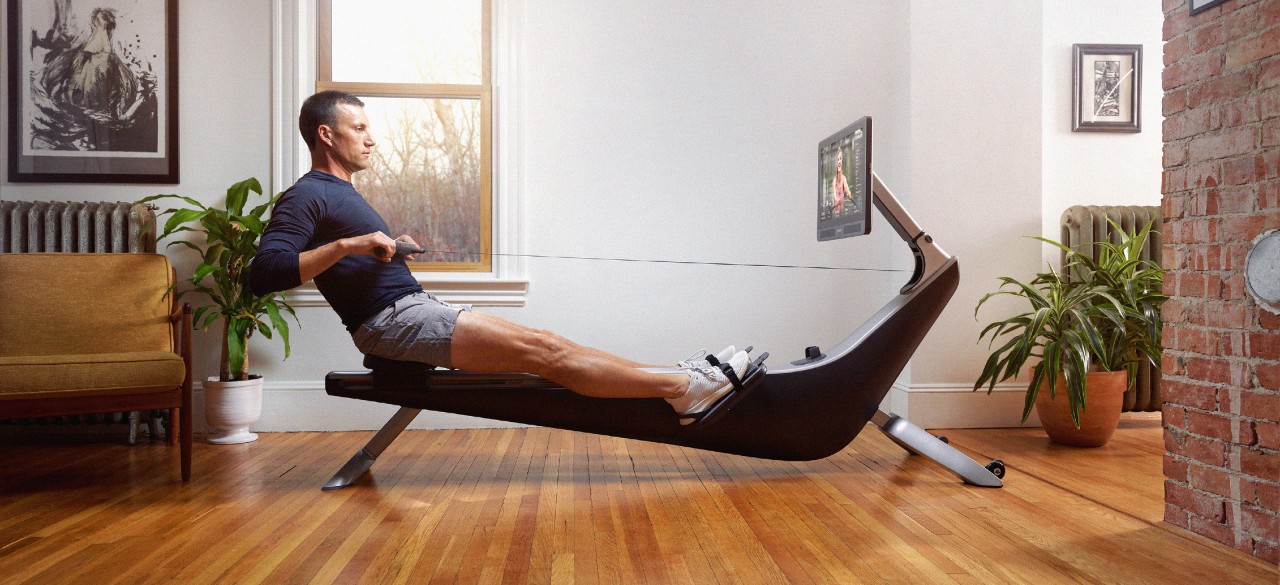Our Verdict
A great choice for those who are new to indoor rowing, Hydrow provides a brilliant Peloton-like experience, plus inspiring workout backdrops and a smart app. It’s big and noisy, so it won’t suit all households, but if you have a good place for it to live it’s highly recommended.
For
- Great for beginners
- Live and on-demand workouts
- Companion smartphone app
Against
- There are cheaper alternatives
- Large and bulky
- Noisy
You can trust Coach
The Peloton connected exercise bike is a phenomenon, so it’s little wonder that competitors quickly sprang up, and the format of live and on-demand classes streamed to a built-in screen was transposed to other types of cardio machines. The Peloton of treadmills is, well, the Peloton Tread, but there are a number of rivals vying to be the Peloton of rowing machines (at least until the Peloton rowing machine goes on sale).
The Hydrow got there first, however, and takes its place among the very best rowing machines, with its large built-in touchscreen offering live or on-demand workouts from a subscription app. Perhaps its most Peloton-like characteristic is that it costs more than its competitors.
The Hydrow costs £2,295 for the machine and requires a monthly subscription of £38. The Echelon Smart Rower costs £1,199 for the rower (there’s no built-in screen – you use a smartphone or tablet) but has a more expensive monthly subscription of £39.99. NordicTrack’s RW900 connected rower is £1,499 for the machine and £29.99 a month for access to its iFit platform (although a one-year subscription is included).
In Peloton’s case the cost is justified by a superior experience. Hydrow, too, aims to offer an all-in-one package that not only will keep you coming back for more, but will also help you become a better indoor rower.
The Set-Up
The Hydrow is huge. It’s the biggest rowing machine I’ve tried, measuring 219cm long, 64cm wide and 120cm high. There’s a sizable display too, which adds to its already quite hulking frame. Ideally you’ll have a dedicated room for it, or a particularly spacious area in a living room or garage gym to put it in.
The box it’s delivered in is a monster too. It was so big that the rower had to be taken out to get it up the stairs to my flat. The usual delivery service will drop it outside of your property, so the size of this thing is something to keep in mind.

There are wheels in the front of the frame so it can be moved around by one person and it can be stored upright, but you’re going to have to stump up another £70 for the upright storage kit (a sturdy hook for a wall, essentially) to do that. The Hydrow is big and heavy, so it’d be preferable to have a dedicated space for it, rather than wrestling with it before and after every workout.
Sign up for workout ideas, training advice, reviews of the latest gear and more.

I was lucky enough to have the Hydrow assembled for me, but in general you will need to put it together yourself. It involves getting the front wheels in place and attaching the display. I’d estimate it would be a 30- to 45-minute, two-person job – you’ll need someone to hold the front of the aluminium and steel frame while the front wheels are attached. The display is a high-quality, 56cm HD touchscreen with an adjustable angle, and it can be folded flat so it doesn’t get in the way when storing the machine vertically.
The Hydrow needs to be plugged in for the electromagnetic resistance to work. You can row without power, but you won’t be able to alter the resistance. There’s a switch near the front of the wheels to turn it on, which boots up the large display that runs on software based on Google’s Android operating system. If you’ve used an Android phone or tablet, navigation will feel familiar.
The first step is to connect to your home Wi-Fi, with the big on-screen keyboard making it easy to tap in your password. Then you drop in your Hydrow subscription code.
An optional part of the process is downloading the companion smartphone app (App Store and Google Play). It adds a convenient way to check activity feeds, your stats, and the schedule of live classes, as well as following the workouts that don’t require the rower.
The first time you log on to Hydrow there’s an introductory video covering fundamental rowing technique and a guide to the on-screen data on display while you row. After that, every time you switch it on you’re presented with a quick-start recommended workout.
You swipe up for more introductory workouts and four-week programmes to follow, which essentially bundle workouts into training camps for beginners, and to improve your endurance or ability to row at speed.
This is also the place where you can see upcoming live rows, featured rowing workouts and popular classes along with the athletes and trainers who lead the classes. There’s a welcome mix of expertise here with some Olympic-level rowers alongside personal trainers.
The Library section contains on-demand workouts, which you can filter by things like duration, trainer, workout type and location. There’s also the Journeys mode, which allows you to ditch the instructors and row solo along scenic rivers, and a variety of other workouts like strength, yoga and Pilates sessions. These are often recommended between rowing workouts, which is a smart touch.
In the Feed tab you can browse workouts other Hydrow users are doing and give them a thumbs up, in the same way you can give Kudos on Strava. There’s also a racing section, which is not the split-screen head-to-head you might imagine, but joining other Hydrow users to chase down a set distance or duration target.
The Progress section provides a calendar view of workouts you’ve logged, along with a list of workouts completed and a record of days active, metres rowed and calories burned. This is also where you’ll find challenges, including one where Hydrow will make a donation to water.org once you rack up 60 days of rowing.
The Experience
Despite the name, the Hydrow is not a water rower like the DKN H2Oar. It uses electromagnetic resistance and a belt drive, like Echelon’s Smart Rower, an approach that should – in theory – mean the machine doesn’t make a huge racket when you use it.
In practice, the Hydrow makes an audible whirring noise that, combined with the sound of the seat moving on the rail, was louder than I anticipated. It certainly made me wary of rowing in the early morning and late at night in case I disturbed my neighbours, and I preferred using headphones to hear the class instructors over the noise.
To adjust the drag (resistance), which recreates the rowing on water sensation, you need to reach forwards to use the touchscreen, which means breaking your stroke rhythm if you’re mid-workout. It would benefit from taking Echelon’s approach and adding resistance buttons to the handles.
Speaking of handles, it’s comfortable to grip, though I found it a bit of a stretch to drop it back into its holder. The footplates are big enough for large trainers and use a Velcro strap to keep your feet in place. The seat cushion is comfortable and it felt as great as it did on my final row as it did on the first.
The live and on-demand workouts are largely the same, featuring an instructor in a boat on the water as opposed to a PT on a rowing machine in a studio. It’s one of the most appealing aspects of Hydrow. The beautiful locations on that big screen make for a thoroughly enjoyable experience.

A live leaderboard is overlaid on the screen, but it can be closed if you want more screen space dedicated to those great backdrops. The stats on display are real-time pace, stroke rate per minute, split times, total metres and calories burned. You can pair up a heart rate monitor for real-time heart rate data too and I had no problems using a Polar H10 chest strap monitor and Polar Verity Sense armband.
I tried a mixture of live classes, of which there are two to three a day, along with on-demand classes and some of the non-rowing workouts. Rowing workouts can last anything from five minutes to 45 minutes and the classes are split into three categories. There’s Drive for maximum effort workouts, Sweat to work on endurance and Breathe as a stress-relieving session. For the workouts off the machine, you don’t get the same category breakdown – instead there are sessions like 10 minutes of glute strength work or a yoga session to help you sleep.
I found the Hydrow provides a satisfying workout, and while it caters to all rowing abilities, its greatest appeal is for beginners. The “learn to row” sessions help to establish correct rowing technique so you get the most from the workouts. By mastering the correct technique, you can make sure that even spending 20 minutes rowing will provide a good workout.
I’m a pretty fit person who runs and swims five to six times a week and the mix of boot camp, strength, HIIT and interval rowing workouts did help me work up a sweat. I would’ve preferred a more challenging maximum resistance level, though.
One thing that stood out to me was how talkative the trainers are. They certainly don’t limit themselves to delivering instructions. You may enjoy this chatty approach, but I took advantage of the option to turn the music up, which makes the chatter less prominent so you can tune it out while still being able to catch the instructions.
That music can be an acquired taste at times and you can’t play your own music through the system. Each workout displays the music for the class and I’ll admit to avoiding taking a class because some of the music on the playlists was a little cheesy for my liking.
Pairing up some headphones via Bluetooth offers the best, most immersive experience. While the built-in speakers offer decent sound quality, they’re fighting a losing battle with the noise once you get rowing.
Ultimately, it’s a polished experience. It’s easy to jump on and get a quick workout fix. If you want something more structured, there’s that too. Plus, with races providing a competitive element, and non-rowing workouts bundled in, there’s plenty to keep your interest.
Verdict
Of the rowing machines I’ve tried, the Hydrow comes the closest to replicating the Peloton experience. It may be expensive and big, but it quickly became something I looked forward to using.
It’s great for beginners and while stronger rowers might demand a wider range of resistance levels, it’s still one that gives a satisfying workout if you’re already pretty fit.
You could pay less for the Echelon Smart Rower, which has a similar set-up and has the advantage of being quieter, but the Hydrow feels like a step up. Yes, it’s expensive, but it works well and offers those gorgeous backdrops to lose yourself in while you row.
More Rowing Machine Reviews
- Echelon Smart Rower review: A slick, if expensive, machine for rowing beginners
- ProForm 750R Rowing Machine review: A more affordable way to bring connected rowing workouts home
- JTX Freedom Air Rowing Machine review: Simple and stylish
- DKN H2Oar Water Rower review: A solid water rower that can be stored upright

Mike is an experienced journalist, beginning his career in 2008, and is a keen runner and swimmer. As a contributor to Coach, he covers swimming and reviews rowing machines.


